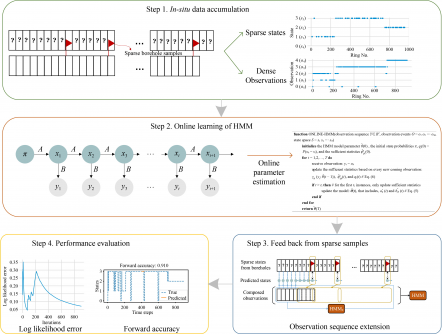Science
New Model Enhances Geological Risk Prediction in Tunnel Excavation

In a significant advancement for tunnel construction, researchers have unveiled a new method for predicting geological risks that could prevent hazardous incidents such as collapses and water inrushes. The study, titled “Geological Risk Prediction Under Uncertainty in Tunnel Excavation Using Online Learning and Hidden Markov Model,” was conducted by a team from the School of Civil and Hydraulic Engineering at Huazhong University of Science and Technology and the School of Civil and Environmental Engineering at Nanyang Technological University.
Accurate estimation of geological risks is critical for ensuring the safety and efficiency of tunnel projects. Traditional data-gathering techniques often struggle with limitations. Invasive methods, such as borehole logging, can reach depths of up to 12 km but provide limited data points, while non-invasive methods, including seismic and electromagnetic techniques, boast better spatial resolution but suffer from measurement inaccuracies.
The challenge is further compounded by conventional machine learning approaches, which often require large datasets before they can effectively predict geological risks. Tunnel projects, which can extend over several years, generate data incrementally, making it difficult for traditional models to adapt as new information becomes available.
To address these issues, the research team proposed the online hidden Markov model (OHMM). This innovative method combines online learning with the hidden Markov model to continuously update its parameters as new data is collected. The OHMM is tailored to the ongoing nature of data collection during tunnel excavation, allowing it to provide real-time risk assessments.
In the early phases of construction, the team introduced an observation extension mechanism that incorporates pre-construction borehole samples. This innovative approach extends short sequences of observed data, creating a more comprehensive dataset that reflects the geological risk of the tunnel coverage area.
The effectiveness of the OHMM was tested in a case study focused on a tunnel excavation project in Singapore, which included 915 rings. When compared to traditional models such as standard hidden Markov models, long short-term memory (LSTM) networks, neural networks (NN), and support vector machines (SVM), the OHMM significantly outperformed its counterparts.
Particularly noteworthy is the model’s ability to forecast geological risks in unconstructed areas, even when limited observational data is available. For instance, utilizing 300 observed rings of data, the OHMM achieved a forward prediction accuracy of 0.968. When the dataset was expanded to 600 observed rings, the accuracy remained high at 0.902, demonstrating a marked improvement over other models.
The OHMM also exhibited stable prediction capabilities for up to 100 rings ahead. Considering the balance between prediction accuracy and stability, the researchers recommend a foresight distance of 30 rings for practical application in tunnel excavation guidance.
The findings from this study represent a substantial leap forward in the field of geological risk assessment in tunnel construction. The full text of the research paper is available at: https://doi.org/10.1007/s42524-024-0082-1.
-

 Sports1 week ago
Sports1 week agoSteve Kerr Supports Jonathan Kuminga After Ejection in Preseason Game
-

 Politics1 week ago
Politics1 week agoDallin H. Oaks Assumes Leadership of Latter-day Saints Church
-

 Lifestyle1 week ago
Lifestyle1 week agoDua Lipa Celebrates Passing GCSE Spanish During World Tour
-

 Business1 week ago
Business1 week agoTyler Technologies Set to Reveal Q3 2025 Earnings on October 22
-

 Science1 week ago
Science1 week agoChicago’s Viral ‘Rat Hole’ Likely Created by Squirrel, Study Reveals
-

 Entertainment1 week ago
Entertainment1 week agoZoe Saldana Advocates for James Cameron’s Avatar Documentary
-

 World1 week ago
World1 week agoD’Angelo, Iconic R&B Singer, Dies at 51 After Cancer Battle
-

 Lifestyle1 week ago
Lifestyle1 week agoKelsea Ballerini Launches ‘Burn the Baggage’ Candle with Ranger Station
-

 Health1 week ago
Health1 week agoRichard Feldman Urges Ban on Menthol in Cigarettes and Vapes
-

 Health1 week ago
Health1 week agoCommunity Unites for Seventh Annual Mental Health Awareness Walk
-

 Business1 week ago
Business1 week agoMega Millions Jackpot Reaches $600 Million Ahead of Drawings
-

 Business1 week ago
Business1 week agoMLB Qualifying Offer Jumps to $22.02 Million for 2024









